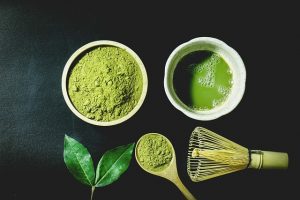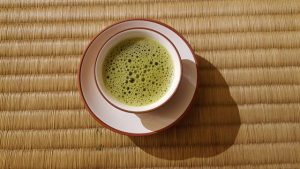The matcha, a little history …

The history of matcha started during a long day wandering in the forest, looking for edible seeds and herbs, the divine cultivator “Shennong” accidentally poisoned himself 72 times. Before the poisons could end his life, a leaf fell into his mouth, he chewed it and came back to life.
That’s how tea was born, or so an ancient legend has it. You have guessed it, haven’t you?
Our topic today is tea, especially MATCHA tea . Indeed, tea does not really cure poisoning but the story of Shennong, the mythical Chinese inventor of agriculture, underlines the importance of tea in ancient China.
Archaeological evidence indicates that tea was first cultivated in China, this original Chinese tea plant is of the same type cultivated in the world today, but originally it was consumed in a different way: it was eaten as a vegetable or cooked with grains.
Tea became a beverage 1500 years ago, when people realized that a combination of heat and moisture could create a varied and original taste only from the leaves.
After years of varying methods, the standard became heating the tea, putting it in cakes, grinding it into a powder, mixing it with hot water and then creating a drink called muo cha or what we know today as matcha.
If you are part of the lovers tea is well this is the opportunity to make you discover a lot of things around the matcha tea, and if you have just discovered it then we invite you to try this extraordinary plant.
Matcha became very popular as a Chinese tea culture was born, the Japanese even developed their own tea rituals, which led to the creation of the Japanese tea ceremony. Gradually, the consumption of matcha tea spread all over the world.
How matcha tea is made:

The matcha goes through a series of steps in order to be reduced to powder:
1 / Shading
The first step is to shade the tea leaves in spring before harvesting. The shading is done over a period of three weeks. As the new shoots grow, the tea bushes are covered to reduce sunlight.
The purpose of this technique is first to soften the spring sunlight falling on the tender young leaves and then to make them produce more chlorophyll.
2 / Plucking
At the beginning of May, the harvesting of tea begins when the young shoots develop into thin, wide and colored leaves. The plucking of the tea leaves is done carefully by hand to guarantee a high quality of matcha.
3 / Drying
The freshly harvested leaves are immediately transported to the processing facility: the first step is to stop oxidation by steam and air drying, to preserve their green color.
The oxidation is also stopped by air drying. These steamed leaves will be transported to a giant dryer. The leaves slowly pass through the oven while losing almost all their moisture. The semi-dried leaves are called Aracha.
4 / Packing
Finally, these leaves are carefully packed in refrigerated units until use. In order to process them into matcha tea, the semi-dried leaves are removed from refrigeration and chopped to a uniform size, then these chopped leaves are put through machines to separate the fleshy parts of the leaf from the stems and veins. It is quite a process to remove all the stems, veins and old leaves and keep only the soft tissue. The final product is known as Tencha which is then ground into matcha.
The benefits of matcha:
More and more, matcha tea is considered a remedy for a healthy and fulfilling life. Matcha tea is a finely ground tea, so when you drink matcha tea you are ingesting the entire leaf and its benefits, unlike conventional tea where you are only consuming an infusion of the benefits of the tea leaf. The benefits of matcha tea are numerous:
Stimulates a lasting energy:
You will no longer need dietary supplements. Rich in L-theanine, it reduces mental and physical stress, increases concentration, improves mood and enhances cognitive performance.
A synonym of immortality elixir:
Benefiting from a power: to purify and beautify your skin. This is due to the high level of epicatechins that reduce inflammation and protect the skin from the harmful effects of the sun and its carcinogenic effects. Therefore, it is suggested to use the tea also as a mask for your face.
A good choice for good health:
Very rich in antioxidants, they act as a protective bulwark against free radicals. Thus thanks to a high level of EGCG, which have as effect: the prevention of tumors, the growth of cancerous cells, improves brain function and allows weight loss.
Weight loss or keeping a good figure:
Regular consumption of matcha tea increases thermogenicity, which is the body’s ability to burn calories. However, you should not consider matcha tea as the only solution, but also adopt a lifestyle in line with your goal.
Can help you live longer
Have you ever heard of the bestseller “IKIGAI” “the japanese secret to a long and happy life”? it’s about the secrets of the Okinawan people who live a hundred years. One of its secrets is their regular consumption of matcha, which strengthens the immune system and prevents certain diseases.
A real delight:
Characterized by a unique flavor and taste, you can find aromas of earth, grass and chlorophyll. Much of its taste comes from the soil and growing conditions, and its taste and quality differs from region to region. You can find good matcha as you can find bad. So how can you tell the difference to choose your treasure?
How to recognize good matcha?
To be able to distinguish good tea from bad, you just have to: check its color. Indeed, a good matcha is characterized by a bright green, brilliant and electric.
How to prepare your tea?
1- Take a few grams of matcha powder and put it in a bowl
2- Pour hot water into the bowl
3- Whisk with a special “chasen” whisk until you get a frothy matcha tea
Final thoughts:
Are you tired of drinking the same old green tea every morning? Chances are you’ve encountered this pretty green powder with a trendy bamboo whisk all over your social media timelines. Indeed, this is one of the most sought-after super foods today. It is characterized by its multiple benefits on the body or on the skin. Herboristerie Principale provides you with a very good quality of matcha to guarantee these benefits. Your health is our priority.
So, tell us in comments how do you cook your matcha?
For more information about matcha, react in comments.
